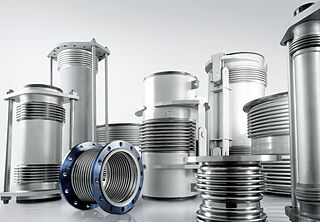
A forge is a type of hearth used for heating metals, or the workplace (smithy) where such a hearth is located. The forge is used by the smith to heat a piece of metal to a temperature where it becomes easier to shape by forging, or to the point where work hardening no longer occurs. The metal is transported to and from the forge using tongs, which are also used to hold the workpiece on the smithy's anvil while the smith works it with a hammer. Sometimes, such as when hardening steel or cooling the work so that it may be handled with bare hands, the workpiece is transported to the slack tub, which rapidly cools the workpiece in a large body of water. However, depending on the metal type, it may require an oil quench or a salt brine instead; many metals require more than plain water hardening. The slack tub also provides water to control the fire in the forge.

Plumbing is any system that conveys fluids for a wide range of applications. Plumbing uses pipes, valves, plumbing fixtures, tanks, and other apparatuses to convey fluids. Heating and cooling (HVAC), waste removal, and potable water delivery are among the most common uses for plumbing, but it is not limited to these applications. The word derives from the Latin for lead, plumbum, as the first effective pipes used in the Roman era were lead pipes.

A blacksmith is a metalsmith who creates objects from wrought iron or steel by forging the metal, using tools to hammer, bend, and cut. Blacksmiths produce objects such as gates, grilles, railings, light fixtures, furniture, sculpture, tools, agricultural implements, decorative and religious items, cooking utensils and weapons. The place where a blacksmith works is called variously a smithy, a forge or a blacksmith's shop.

A steel mill or steelworks is an industrial plant for the manufacture of steel. It may be an integrated steel works carrying out all steps of steelmaking from smelting iron ore to rolled product, but may also describe plants where steel semi-finished casting products are made, from molten pig iron or from scrap.

Sheet metal is metal formed by an industrial process into thin, flat pieces. Sheet metal is one of the fundamental forms used in metalworking and it can be cut and bent into a variety of shapes. Countless everyday objects are fabricated from sheet metal. Thicknesses can vary significantly; extremely thin sheets are considered foil or leaf, and pieces thicker than 6 mm (0.25 in) are considered plate steel or "structural steel."

A vise or vice is a mechanical apparatus used to secure an object to allow work to be performed on it. Vises have two parallel jaws, one fixed and the other movable, threaded in and out by a screw and lever.

In common usage the words pipe and tube are usually interchangeable, but in industry and engineering, the terms are uniquely defined. Depending on the applicable standard to which it is manufactured, pipe is generally specified by a nominal diameter with a constant outside diameter (OD) and a schedule that defines the thickness. Tube is most often specified by the OD and wall thickness, but may be specified by any two of OD, inside diameter (ID), and wall thickness. Pipe is generally manufactured to one of several international and national industrial standards. While similar standards exist for specific industry application tubing, tube is often made to custom sizes and a broader range of diameters and tolerances. Many industrial and government standards exist for the production of pipe and tubing. The term "tube" is also commonly applied to non-cylindrical sections, i.e., square or rectangular tubing. In general, "pipe" is the more common term in most of the world, whereas "tube" is more widely used in the United States.

An expansion joint or movement joint is an assembly designed to hold parts together while safely absorbing temperature-induced expansion and contraction of building materials, and vibration, or to allow movement due to ground settlement or seismic activity. They are commonly found between sections of buildings, bridges, sidewalks, railway tracks, piping systems, ships, and other structures.

A fitting or adapter is used in pipe systems to connect straight sections of pipe or tube, adapt to different sizes or shapes, and for other purposes such as regulating fluid flow. These fittings are used in plumbing to manipulate the conveyance of water, gas, or liquid waste in domestic or commercial environments, within a system of pipes or tubes.

Pipe fitting or pipefitting is the occupation of installing or repairing piping or tubing systems that convey liquid, gas, and occasionally solid materials. This work involves selecting and preparing pipe or tubing, joining it together by various means, and the location and repair of leaks.
This glossary of woodworking lists a number of specialized terms and concepts used in woodworking, carpentry, and related disciplines.

Butt welding is a commonly used technique in welding that can either be automated or done by hand on steel pieces. Butt welding can also be done with brazing for copper pieces. It is used to attach two pieces of metal together such as pipe, framework in factories, and also flanges. A flange is something that either is internal or external that provided to strengthen a piece of material. In factories butt welding has shown how economical it can be for companies to use when building things out of metal. This is because if they wanted to make something out of metal without welding it together they would have to bend everything and reinforce the structure which costs more than welding the two pieces together. Butt welding is accomplished by heating up two pieces of metal, or applying pressure, or doing both of those. Penetration while welding the metal is important to maintain and with thin pieces of metal this is possible however, with thick pieces edge preparation may have to be done to prepare the metal. Full penetration butt welds are made when they are in the within the parent(bigger, stronger) metal. In butt welding the strongest welds will have the fewest imperfections. To achieve this the heat input is controlled, which decreases the size of the weld. In commercial welding when this is done it also reduces cost but in order to maintain the strength of the weld double butt welds will be used. In butt welding there are two types used to achieve the specific welds and then there are also a variety of joints considered to be butt joints.
Structural shape rolling, also known as shape rolling and profile rolling, is the rolling and roll forming of structural shapes by passing them through a rolling mill to bend or deform the workpiece to a desired shape while maintaining a constant cross-section. Structural shapes that can be made with this metal forming process include I-beams, H-beams, T-beams, U-beams, angle iron, channels, bar stock, and railroad rails. The most commonly rolled material is structural steel. Other metals, plastic, paper, and glass can also be rolled. Common applications include railroads, bridges, roller coasters, art, and architectural applications.

Tube bending is the umbrella term for metal forming processes used to permanently form pipes or tubing. One must differentiate between form-bound and freeform-bending procedures, as well as between heat supported and cold forming procedures.
Process duct work conveys large volumes of hot, dusty air from processing equipment to mills, baghouses to other process equipment. Process duct work may be round or rectangular. Although round duct work costs more to fabricate than rectangular duct work, it requires fewer stiffeners and is favored in many applications over rectangular ductwork.

Ductile iron pipe is a pipe made of ductile cast iron commonly used for potable water transmission and distribution. This type of pipe is a direct development of earlier cast iron pipe, which it has superseded. The ductile iron used to manufacture the pipe is characterized by the spheroidal or nodular nature of the graphite within the iron. Typically, the pipe is manufactured using centrifugal casting in metal or resin lined moulds. Protective internal linings and external coatings are often applied to ductile iron pipes to inhibit corrosion: the standard internal lining is cement mortar and standard external coatings include bonded zinc, asphalt or water-based paint. In highly corrosive environments loose polyethylene sleeving (LPS) to encase the pipe may also be used. Life expectancy of unprotected ductile iron pipes depends on the corrosiveness of soil present and tends to be shorter where soil is highly corrosive. However, a lifespan in excess of 100 years has been estimated for ductile iron pipelines installed using "evolved laying practices", including use of properly installed LPS. Studies of ductile iron pipe's environmental impact have differing findings regarding emissions and energy consumed. Ductile iron pipe manufactured in the United States has been certified as a sustainable product by the Institute for Market Transformation to Sustainability.
Cast iron pipe is a pipe which has had historic use as a pressure pipe for transmission of water, gas and sewage, and as a water drainage pipe during the 17th, 18th, 19th and 20th centuries. It comprises predominantly a gray cast iron tube and was frequently used uncoated, although later coatings and linings reduced corrosion and improved hydraulics. In cast iron pipe, the graphite forms flakes during the casting process, when examined under a microscope. Cast iron pipe was superseded by ductile iron pipe, which is a direct development, with most existing manufacturing plants transitioning to the new material during the 1970s and 1980s. Ductile iron pipe is different than cast iron, because the introduction of magnesium during the casting process causes the graphite to form spheres rather than flakes. While this allows the material to remain castable, the end product is much tougher than cast iron, and allows elastic behavior at lower stress levels. Little cast iron pipe is currently manufactured, since ductile iron pipe is widely accepted as a superior product. Many public utilities, municipalities, and private industries still have functional cast iron pipe in service to this day.

Metal expansion joints are compensating elements for thermal expansion and relative movement in pipelines, containers and machines. They consist of one or more metal bellows, connectors at both ends, and tie rods that depend on the application. They are differentiated according to the three basic types of movement: axial, angular and lateral expansion joints. Expansion joints have usage in various sectors, like energy productions, paper industry, chemical industry, water treatment, oil and gas. Everywhere where exist pipelines and occurs thermal movements or vibration, then expansion joints can be used.
ASME is a non-profit organization that continues to develop and maintains nearly 600 codes and standards in a wide range of disciplines. Some of which includes the Boiler and Pressure Vessel Code (BPVC), Elevators and Escalators, Piping and Pipelines, Bioprocessing Equipment (BPE), Nuclear Facility Applications (NQA), Process Performance Test Codes (PTC), and Valves, Flanges, Fittings and Gaskets (B16).
A cable protection system (CPS) protects subsea power cables against various factors that negatively impact on the cable lifetime, normally used when entering an offshore structure. When a subsea power cable is laid, there is an area where the cable can be subjected to increased dynamic forces, which the cable is not necessarily designed to survive over the lifetime of the installation.
















